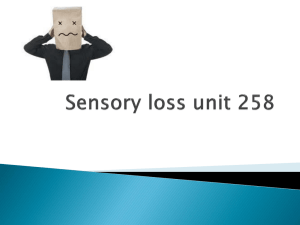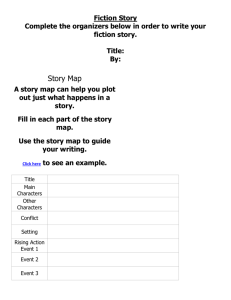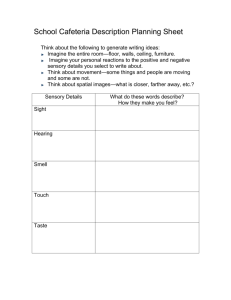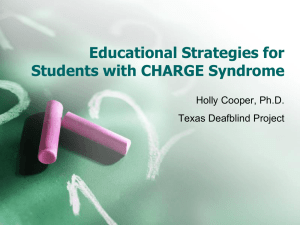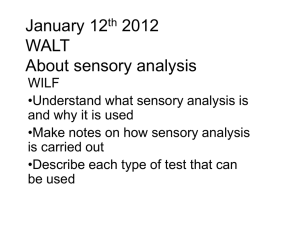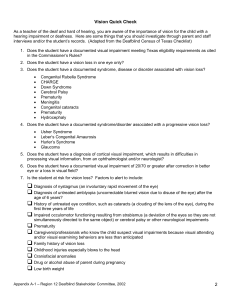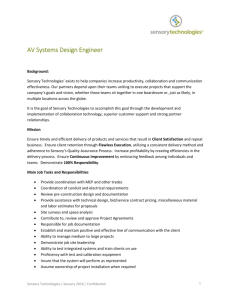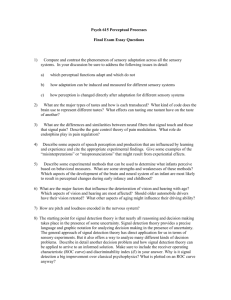Sensory Impairment Awareness Training Workbook
advertisement
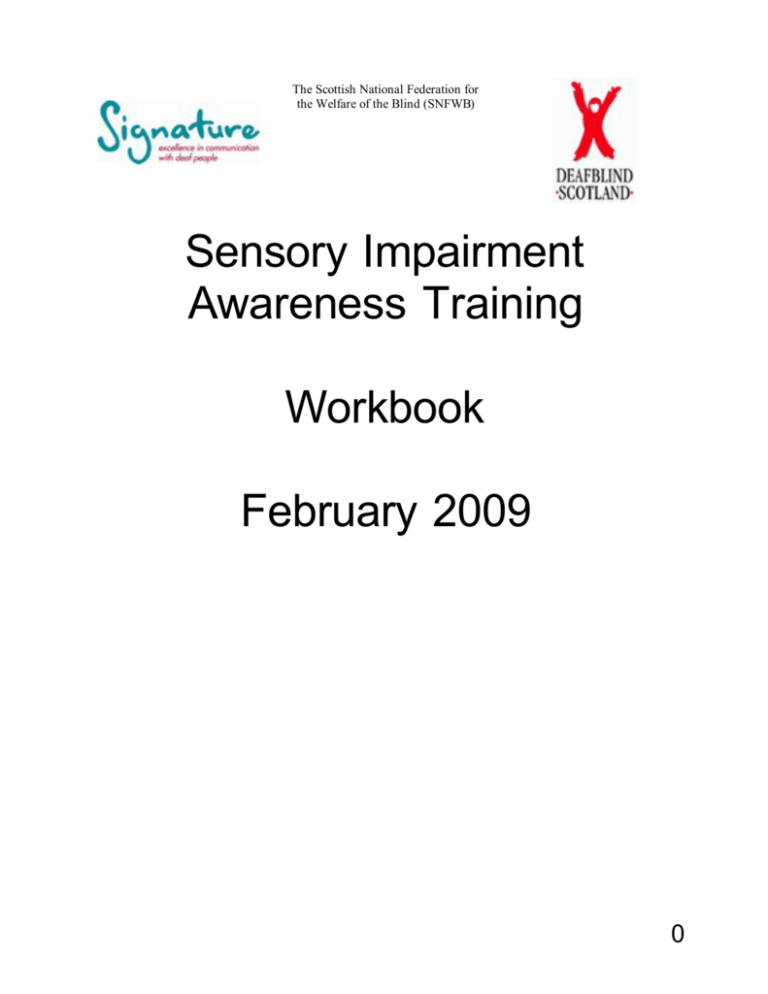
The Scottish National Federation for the Welfare of the Blind (SNFWB) Sensory Impairment Awareness Training Workbook February 2009 0 Contents Introduction 2 Programme Course aim and objectives Learning outcomes Sensory Impairment or Sensory Loss 3 5 6 7 Blind/Partially sighted Deaf Deafblind Commonl y used terms What are some of the causes of Sensory Impairment How do we recognise Sensory Impairment? 8 10 12 14 15 What is the impact of different sensory losses on the individual? 17 Communi cation and Access 18 Maximising Communi cation Guiding Awareness 19 22 Benefits and Concessions 23 Practical Communi cation 26 Environmental impact for sensory impaired people 29 Equipment Practical Training Where to go for helpful information? 30 31 Where to now? 32 16 1 On behalf of the Scottish Government this pack has been developed by the Scottish National Federation for the Welfare of the Blind, Signature (formally known as CACDP), and Deafblind Scotland. As a result of the work of the Sensory Impairment Action Plan Group within the Scottish Government a need for a training pack on basic sensory impairment awarenes s was identified. A working group including representatives of SNFW B, Signature and Deafblind Scotland, and funded by the Scottish Government , was set up to develop the day course and this pack is the result of those efforts. This pack is designed to provide basic training in sensory impairment to all levels of staff. It is designed to be delivered by people who have experienced sensory loss as it is considered essential for participants to meet people who have sensory loss. Signature is a UK awarding body of accredited qualifications aimed at advancing communi cation between deaf and hearing people. Content marked with * in this workbook is taken from the Signature level 1 Certificate in Developing Awareness and Communi cation with Deaf and Deafblind People (DAC1). With some additional hours of training, individuals could achieve the DAC 1 qualification. SNFW B is the Scottish umbrella organisation for visual impairment organisations. SNFW B has just developed a new training pack and information on this and other VI training is available from SNFW B. Deafblind Scotland is a specialist members hip organisation serving adults who have a dual sensory loss. Contact details of organisations are to be found on page 31 and information on training pathways on page 32. 2 Programme 9.30am Icebreaker Introductions Ground rules Course aims and objectives, learning outcomes 10.00 Sensory Impairment or Sensory Loss What does it mean? What are the numbers ? What are the causes? 11.00 Break 11.15am Sensory Impairment - commonl y used terms Which is better and why? 11.25am Common causes of deafness, blindness and partial sight, and deafblindness 11.35am How do we recognise sensory impairment? 12.00pm What are the Communi cation and Access problems? The impact on the individual? 12.30pm Lunch 1.30pm What can I do to maximise communi cation? 2.15pm Practical communi cation skills 2.30pm Break 3 2.45pm How can I improve the environment What practical help is available? 3.30pm Useful Organisations 3.45pm Any questions? 4.00pm What next? 4 Course Aim To increase awarenes s of sensory impairment issues and assist participants to make positive changes in their workplace Course Objectives Participants will: · be able to more effectively identify sensory impairment in those they come into contact with · become aware of t he full range of sensory impairments · be aware of the terminology used · become aware of some of the needs of individuals who have a sensory impairment · be able to address sensory impairment issues in the workplace with greater confidence · be more effective in communi cating with those who have a sensory impairment · have an awarenes s of the wider services available for people who have a sensory impairment 5 Learning Outcomes Participants will understand:· Some of the causes of sensory impairment · The use of effective communi cation tactics · Alternative ways of accessing information · Helpful organisations, equipment, and websites, for those with a sensory impairment · Further training opportunities This course is aimed at frontline staff whose work involves assisting people who have a sensory impairment, particularly those employed in social care and health 6 Sensory Impairment or Sensory loss What does it mean? Sensory impairment or sensory loss is an umbrella term used to describe loss of the distance senses i.e. sight and hearing. This term may be used for example to describe a centre where deaf people or blind/partially sighted people can access services or to describe the contents of a report. Individuals would rarely describe themselves as having a sensory impairment. Individuals are more likely to use the terms below. There are three very distinct groups within sensory impairment: · Blind and partially sighted people · Deaf people · Deafblind people Each of these groups: Ø may or may not come into contact with the other two groups Ø has its own range of very distinct needs Ø is made up of individuals with their own distinct needs. We will look in more detail at each of the three groups. 7 Blind/Partially sighted - what does it mean? There is a definition of blindness which is 60 years old and really quite out of date. This states that the person can be registered blind when they are “unable to carry out any work for which eyesight is essential” (National Assistance Act, section 29, 1948) An opthalmologist will suggest registration via a BP1 form when the person’s visual acuity is less than 3/60 or when they have a severely reduced field of vision. Registration is voluntary on the part of the individual, but local authorities are required to keep a register. Visual acuity of 3/60 means that the person can see an object at 3 metres distance what a person with standard eyesight would see at 60 metres distance. Many elderly people, particularly those who are frail, will not take the trouble to be registered. Most people who are registered blind have a little useful vision. People can also be registered as Partially Sighted under Section 29, if they are “substantially and permanent ly handicapped by defective vision, caused by congenital defect or illness or injury”. (National Assistance Act, section 29, 1948) People who have a visual impairment, depending on the cause, can appear to see things very differently. 8 Exercise 1 – experiential exercise on sight loss Below are just two examples of the different ways visual loss can present. For more examples see www.stlukeseye.com: Normal vision Loss of central Vision Loss of peripheral vision People who have lost central vision will find it difficult to read, focus, see faces, watch TV. Those who are losing peripheral vision will find it increasingly difficult to safely get around by themselves. What are the numbers on those who are blind or partially sighted? In the Scottish Executive Statistics Release Registered Blind and Partially Sighted Persons, Scotland 2007 the number registered are given as follows: Scotland Number of people registered blind 22,561 Number of people registered partially sighted 15,435 The majority (85 per cent) of people with sight problems are older people, aged over 65. (www.rnib.org.uk - RNIB,2006) 9 Deaf - what does it mean?* There is no definition of deafness. Deafness may be described, in medical terms, as: Mild Moderate Severe Profound Gunshot Level of hearing loss 20 – 40 decibels 41 – 70 decibels 71 – 95 decibels 95+ decibels 140 dB 130 Ambulance Siren 120 110 100 Lawnmower 90 80 70 Normal Speech Bird song 60 50 40 30 Whisper 20 10 0 Comparatively few people are profoundly deaf. They may use Sign Language or Lipreading to communicate. It is more common for people to have a little useful hearing, particularly with the help of hearing aids. At a loss of more than 60 decibels it becomes difficult to understand speech. If we ask the question “Can you hear me?” most people will answer yes. But they may not be able to hear enough to fully comprehend what you say. Hearing aids amplify sound, including background noise. This can make it difficult for the wearer to hear speech clearly. A loop system might help this problem. For explanation of what a loop system is see page 29. 10 What are the numbers on people who are deaf? Deaf people are not registered deaf. There is no central register of deafness However RNID estimates that one in seven people in the UK have a hearing loss. Scottish Council on Deafness estimate that one in five of the Scottish population have a hearing loss. Figures are given for the whole of the UK of which there are approximately 60 million people. Signature estimate*: UK Scotland The total number of people of all ages with deafness ranging from mild to profound: The number of hard of hearing people: The number of deafened people (those who become profoundly deaf either suddenly or progressively): 9 million (1 in 7 of the population) 8.3 million 750,000 123,000 10,500 The number of Deaf British Sign Language (BSL) users: 50,000 4,3005,300 715,000 The incidence of deafness increases sharply with age, so the older you are the more likely you are to have a hearing loss. Exercise 2 – experiential exercise on hearing loss 11 Deafblind - what does it mean?* The generally accepted definition of deafblindness across Europe is: “Persons are regarded as deafblind if they have a severe degree of combined visual and auditory impairment, resulting in problems with communi cation, information and mobility”. (“Breaking Through” Report, 1988) The terms dual sensory loss, dual sensory impairment and deafblind are used interchangeabl y There are two recognisably very distinct groups within deafblindness, those who are: Congeni tally deafblind, having been born with a dual sensory impairment or having developed it in early childhood and those who have: Acquired deafblindness, having been born with vision and/or hearing and having lost one or both some time after childhood, normally in later life. This group include those who have Usher Syndrome. What are the numbers on people who are deafblind? There is no registration for deafblindness. However, the “Breaking Through” Report (1988) estimated 4:10,000 people are deafblind, giving 2,500 people with a dual sensory impairment in Scotland. 12 In the Scottish Executive Statistics Release 2007, those who are registered blind or partially sighted and also have a hearing impairment number more than 2,600. However these figures may not include people who have been deaf or hearing impaired since birth and may never enter the system for registration of visual loss. Deafblind Scotland estimates there are 5,000 deafblind people in Scotland. Because of the effects of the ageing process, a large proportion of the numbers given for sensory impairment are people over 75. Signature estimate that *: UK The number of people (mainly elderly) 250,000 who people experience some level of dual sensory loss: The number of deafblind people 24,000 (defined as those who experience a level of dual sensory loss that has a significant effect on their ability to access communication, mobility and information): Scotland 25,000 2,040 Exercise 3 – experiential exercise of deafblindness 13 Commonl y Used Terms - Which is better and why? Commonl y used terms within Sensory Loss or Sensory Impairment. List terms which may be acceptable or unacceptable. GROUP DISCUSSION 1 Acceptabl e terminology* Unacceptabl e terminology * Don’t be afraid to use standard phrases like “Did you see?” to a blind person, or “Did you hear?” to a deaf person. Don’t be quick to use the label “deafblind” as people may not yet be ready to accept their dual sensory loss. 14 What are some of the causes of Sensory Impairment? The following list gives examples of some common c auses. For further information on the huge number of causes of sensory impairment, their symptoms and their effects, please refer to the appropriate websites on page 30. Blindness/ partial sight Macular Degenerat ion Cataract Glaucoma Diabetic Retinopathy Genetic eg Retinitis Pigmentosa Nystagmus Deafness Sensori-neural damage Childhood infections Exposure to loud noise Genetic Deafblindness Usher Syndrome Congenital causes Maternal infection Ageing process Combination of causes of deafness and blindness 15 How do we recognise Sensory Impairment? Loss of sight Loss of hearing * Loss of both sight and hearing * GROUP DISCUSSION 2 What are the “clues” which may alert us to a person’s visual loss, hearing loss, or dual sensory loss? What are the difficulties involved in identifying dual sensory loss? How might we overcome them? What is the impact of different sensory losses on the individual? 16 What is the impact of different sensory losses on the individual? GROUP DISCUSSION 3 List the day to day difficulties identified GROUP DISCUSSION Discuss the possible longer term impact on the individual 17 Communi cation and Access What are the problems referring to communi cation and access to information? Blindness/ partial sight Not being able to access printed material Difficulty in accessing Internet Difficulty in getting to destinations and around the built environment Accessing unfamiliar buildings and environments Lack of awarenes s of how to help Deafness Not being able to access spoken material English as a second language Difficulties with lipreading Difficulty in accessing BSL interpreters Difficulty in accessing loop systems are satisfactory Lack of awarenes s of how to help Deafblindness All of the above plus: Not having access to guide/communi cator service or communi cation support Lack of awarenes s of the possibility of dual sensory loss Lack of awarenes s of how to help 18 Maximising communi cation for blind/partially sighted people · Always identify yourself even in known surroundings · Always use names to identify people - especially in a group situation · Keep the visually impaired person informed of people moving around and/or leaving the room/table etc. Every time. · Don’t be concerned about using phrases such as “did you see Alice yesterday?” · Do not use non-verbal communi cation e.g. poi nting in the direction of something, shrugging shoulders, pulling faces · Keep physical contact to a minimum · Provide information in alternative formats CD, email Extra Large print Audio tapes Electronic formats, Braille Moon Large print Internet used as audio Under Disability Discrimination Act, provision of information in alternative formats is considered reasonable adjustment. 19 Maximising communi cation for deaf people* · Ask if they want to use a loop system · Try to establish the person’s preferred communi cation method · If necessary book BSL interpreters, lipspeaker, keyboard interpreter etc well in advance · Face the person · Use clear speech, normal lip pattern, don’t shout · Use finger spelling · Speak at ear level · Repeat, rephrase · Write things down · Ensure there is no echo - room with soft furnishings · Quiet situation Maximising communi cation for deafblind people* Follow all the guidelines for blind and deaf people and then additionally: · Good lighting is essential · Plain background · Light must be on the person speaking and coming from behind the deafblind person. · Distance is important, check their preferred distance. 20 · Use whiteboard, or paper, with black felt tip pen. · Provide a guide/communi cator to help deafblind person prepare for a meeting as well as support them on the day. For all 3 groups · · · · · · Allow extra time Prepare an appropriate room Book the necessary communi cation support Arrange for the alternative formats to be provided Take time to get the environment right. Look at this as providing the equivalent of a ramp for wheelchair users. 21 Guiding Awareness We do not teach guiding on this one day course, but awarenes s of the following steps may help keep a deafblind person safe. If the person can hear, talk to them, tell them what is around them and where exactly it is Ask the person what you can do to help. If they wish to be taken a short distance e.g. to a nearby room then proceed as follows: · You must always be in front, the deafblind person will follow · Offer them your elbow then keep your elbow at the side of your body. This will automatically mean you are in front. · Don’t look at their feet, look ahead · Take their hand and gently put it on the chair/door/cup · Never push them backwards into a chair, take their hand and gently put it on the back of the chair More specific training on guiding skills can be obtained from a range of organisations. Refer to the website found on page 30. 22 Benefits and Concessi ons People with a sensory impairment may benefit from: Blind/ Partially sighted Deaf Deafblind National Entitlement Card is available from Local Authorities in Scotland to people who are registered blind or partially sighted. Free travel on buses and trains for those registered blind or partially sighted. Free travel only on buses for deaf. Disabled Person’s Car Badge People who are registered blind are entitled to apply for a disabled person’s car badge, which allows parking in a restricted areas under certain conditions.. P P P Free Eyesight Tests Everyone in Scotland is entitled to a free NHS eyesight test every 2 years and more often if required due to a sight condition. P P P Free Phone Calls to Directory Enquiries are available to people who are registered blind or partially sighted. P P P TV Licence A registered blind person is entitled to a reduction of 50% from the full cost of their TV licence. P P P P 23 Blind/ partially sighted Postal Concessions Articles specifically designed for the use of visually impaired people can be posted free of charge. P Welfare Rights– Blind/partially sighted, Deaf, Deafblind People who are visually impaired may be eligible for a wide range of benefits P Free hearing aid batteries Language Service Professional (LSP)– those who are deaf or deafblind may be require the services of a LSP which can include: · BSL to English Interpreter · Lipspeaker · Speech to Text Deaf Deafblind P P P P P P P LSP is the group term for those who provide communication support or interpreting services. Deafblind people often have a need for a guide/communicator service. Especially in health settings under MEL(1998)4. NB. It is essential to book LSPs well in advance 24 GROUP DISCUSSION 4 If an older person has problems with communi cation and accessing information what would be the issues to overcome when: Getting a new home help service? Visiting a GP? Having a repair done in their house? 25 Practical Communi cation Exercise 4 Introducti on to fingerspel ling * Signature T101 pre-course study booklet The Two-handed Fingerspelling Alphabet 26 Introducti on to Deafblind Manual* Deafblind Scotland 21 Alexandra Ave Lenzie, Glasgow, G66 5BG Tel/Text: 0141 777 6111 Fax: 0141 775 3311 Helpline: 0800 132320 (24hrs) 27 Introducti on to Block * Signature T101 pre-course study booklet The Block Alphabet The broken lines indicate the DIRECTION and SEQUENCE of strokes to be made on the palm Quick signs - For “YES”: 2 taps on the palm of the hand. For “NO” or for erasing an error: a rubbing out mov ement across the palm . 28 Environmental impact for sensory impaired people Think of your working environment where it is accessed by the public, any one of whom could have a sensory impairment. What would work for or against blind/partially sighted people, deaf people and deafblind people? GROUP DISCUSSION 5 What would be the difficulties they would meet? To create a communi cative environment what would you need to do? The list of adaptations might include: Lighting, background, seating/positioning,equipment, loop system, door access, glare, obstacles, communication 29 Equipment Practical Training There is a vast range of equipment available for purchase and/or use by those who have a sensory impairment. It is always better to check with the individual as to their needs and preferenc es. And to allow them to try it for themselves We have listed some examples. Equipment that needs: Hearing - Talking equipment - e.g. scales, thermomet er Talking timepieces – e.g. watches, clocks Loop system – a system that helps deaf people who use a hearing aid or loop listener hear sounds more clearly because it reduces or cuts out background noise. The user can pick up the sound signals if they are sitting within the area of the loop and their hearing aid – or loop listening aid – is set to ‘T’ Communi cation - large button phones, amplified phones Vision – Magnifiers - handheld, tabletop, mains powered Flashing alerts – alarm clocks, minicoms, Communi cation – minicom, faxes Vibration - Doorbells, smoke alarms, pagers Linguistic Access for deaf and deafblind people For some people, particularly those who have a dual sensory loss, there is no substitute for human support, particularly with communi cation and with guiding. A whole range of professionals exists to support deaf and deafblind people to access the spoken and/or written word and the built environment, some are listed on p23. 30 Where to go for helpful information? National Organisations The Scottish National Federation for the Welfare of the Blind 8 Netherlea Scone, Perth, PH2 6QA Tel: 01738 626 969 Email: richard.mazur@virgin.net Website: www.snfwb.org.uk Scottish Council on Deafness Central Chambers Suite 62 93 Hope Street Glasgow, G2 6LD Tel: 0141 248 2474 Text: 0141 248 2477 Fax: 0141 248 2479 Email: admin@scod.org.uk Website: www.scod.org.uk Signature Scotland Office TouchBase Communi ty Suite 43 Middlesex Street Glasgow, G41 1EE Tel: 0141 418 7191 Text: 0141 418 7193 Fax: 0141 418 7192 Email: glasgow@signature.co.uk Website: www.signature.org.uk Deafblind Scotland 21 Alexandra Avenue Lenzie, Glasgow, G66 5BG Tel/text: 0141 777 6111 Fax: 0141 775 3311 Email: info@deafblindscotland.org.uk Website: www.deafblindscotland.org.uk 31 Where to now? Sensory Impairment - Training Pathways 2007 Sensory Impairment Awareness Training Devised by Scottish Executive / Signature/ SNFWB / Deafblind Scotland Equalities Training Sensory Impairment Training (6 hours) Hearing Loss Signature Level 1 Dev Awareness with Deaf & Deafblind DAC1 Remaining 14 hours Signature Level 2 Communication with Deaf People (CDA2) Signature Level 1 Certificate in British Sign Language (BSL1) (50 hours) Signature Level 2 Certificate in British Sign Language (BSL2) Signature Level 3 Facilitating Communication with Deaf People (FLS3,FNT3) Dual Sensory Loss Signature Level 1 Dev Awareness with Deaf & Deafblind DAC1 Remaining 14 hours Signature Level 2 Communication with Deafblind People (Manual) (CDC2) (50 hours) Signature Level 1 Certificate in British Sign Language (BSL1) (50 hours) Signature Level 3 Facilitating Communication with Deafblind People (Manual) (FDB3) (60 Hours) Signature Level 2 Certificate in British Sign Language (BSL2) Visual Loss Basic Visual Impairment Awareness Basic Introduction to Guiding (In progress) Advanced Visual Impairment Guiding (In progress) Eye conditions and their impact (In progress) Accessible information and communication (In progress) Visual Impairment and Dementia (In progress) Signature Level 3 Certificate in British Sign Language (BSL3) Level 4 NVQ British Sign Language (BSN4) Level 4 NVQ in Interpreting BSL/English (INT4) Signature P302 Certificate for LSPs working with Deafblind People (Manual) (LDB3) (20 Hours) Signature Level 3 Certificate in British Sign Language (BSL3) Deafblind Studies Diploma (2 years) Visual Impairment and Learning Disability National Occupational Standards have been developed via Scottish Social Services Council and a qualifications framework will be agreed in the future. 32
